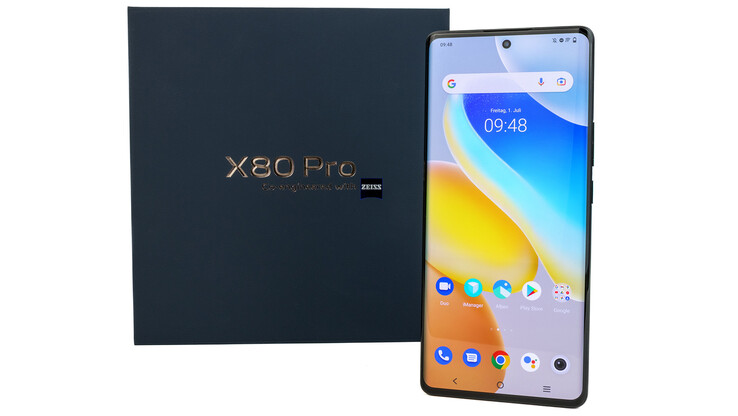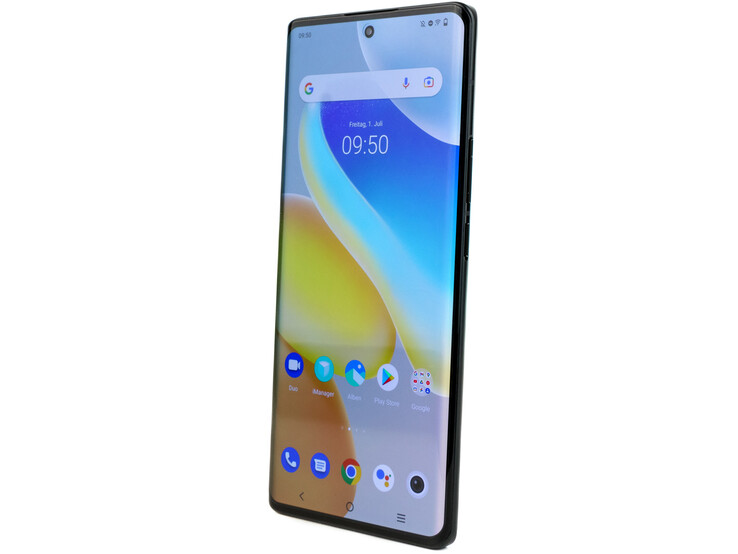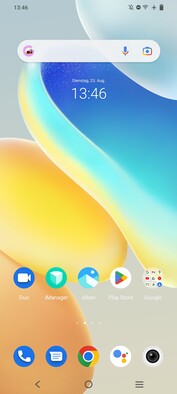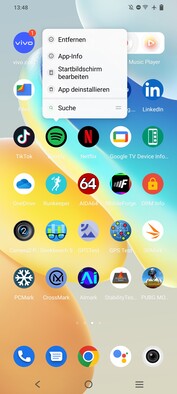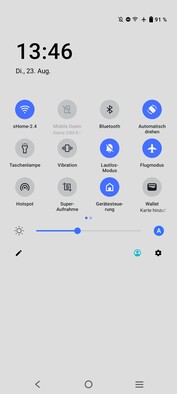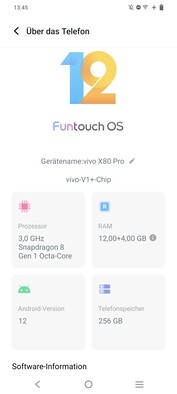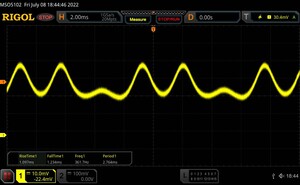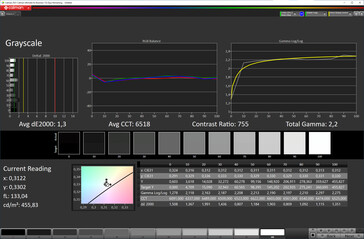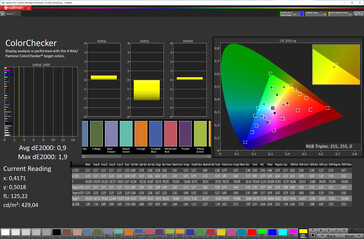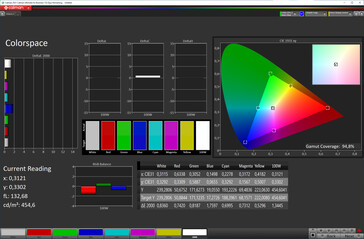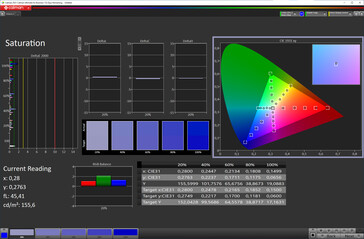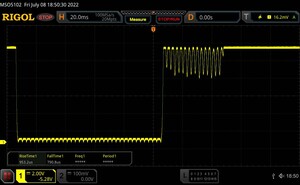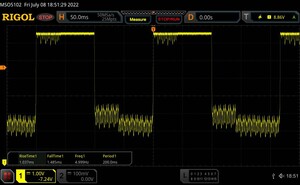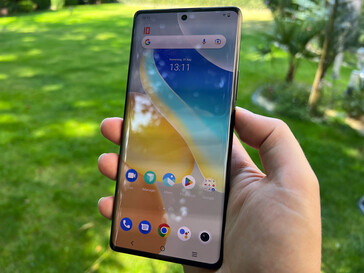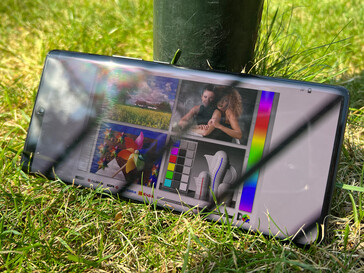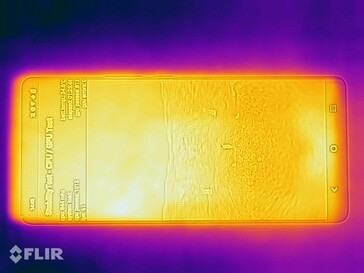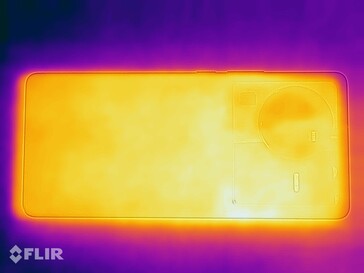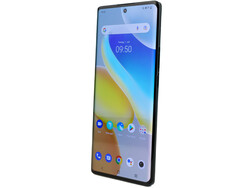Vivo X80 Pro smartphone review: Primus camera with huge fingerprint sensor
After Vivo shipped a slimmed-down version of the X60 Pro with the X61 in 2020 and completely cancelled the X70 series for Europe last year, the full flagship experience is coming to us this year. As part of the BBK Group, which also includes Oppo, realme, and OnePlus, Vivo is attempting to create a particularly strong camera package and has been working with the German company Zeiss for quite some time in this regard. This not only includes the lenses, but also the software algorithms (since the X80 Pro).
Vivo bundles everything in a visually and technically appealing high-end smartphone that conceals an incredibly large fingerprint sensor under the display, which we already know from the Vivo X Note. Our review reviews whether this is enough to justify the high price of around US$1,300.
Possible Competitors in Comparison
Rating | Date | Model | Weight | Drive | Size | Resolution | Price |
|---|---|---|---|---|---|---|---|
| 88.5 % v7 (old) | 09 / 2022 | Vivo X80 Pro SD 8 Gen 1, Adreno 730 | 215 g | 256 GB UFS 3.1 Flash | 6.78" | 3200x1440 | |
| 89.4 % v7 (old) | 03 / 2022 | Samsung Galaxy S22 Ultra 5G Exynos 2200, Xclipse 920 | 228 g | 128 GB UFS 3.1 Flash | 6.80" | 3088x1440 | |
| 89.2 % v7 (old) | 04 / 2022 | Oppo Find X5 Pro SD 8 Gen 1, Adreno 730 | 221 g | 256 GB UFS 3.1 Flash | 6.70" | 3216x1440 | |
| 87.5 % v7 (old) | 08 / 2022 | ZTE Axon 40 Ultra SD 8 Gen 1, Adreno 730 | 204 g | 128 GB UFS 3.1 Flash | 6.80" | 2480x1116 | |
| 87.6 % v7 (old) | 02 / 2022 | Xiaomi 12 Pro SD 8 Gen 1, Adreno 730 | 204 g | 256 GB UFS 3.1 Flash | 6.73" | 3200x1440 |
Case - Lots of glass and great haptics
Worldwide, the Vivo X80 Pro comes in three colors: Cosmic Black, Blue and Orange. The range of these colors, however, may vary from location to location. For example, only Cosmic Black is available in Germany, hence the color of our review sample. Our black smartphone is equipped with an unspecified kind of glass on the front and back. It is matte on the back and feels slightly roughened, which makes it not only haptically pleasing but also fingerprint-proof.
Although the camera is very prominent and protrudes up to 2.1 millimeters, its width ensures that the X80 Pro sits firmly on the table. We particularly like the build quality. Gaps are mostly even; only in the round corners, where the back meets the aluminum frame, are they not quite even. On the other hand, torsional stiffness is very good, which is why the Vivo smartphone hardly makes a peep when we try to bend it.
The X80 Pro is IP68 certified, namely dust- and waterproof. The SIM slot has an aluminum cover and connects seamlessly with the frame, whereas the card holder is made of plastic.
Equipment - Vivo X80 Pro without microSD support
The Vivo X80 Pro possesses a USB 3.2 port (Gen. 1), which not only enables fast data transfers, but also wired image output to HDMI or DisplayPort interfaces, provided an optional adapter is used.
The remaining equipment is quite comprehensive and includes NFC, Bluetooth 5.2, an IR blaster for controlling home entertainment devices, climate control, cameras and more. The lack of options for memory expansion via microSD card is certainly acceptable due to the large memory, but a UWB chip could have been installed for this price range.
Software - Vivo smartphone with Funtouch OS
The Vivo X80 Pro comes with Google Android 12 and the in-house Funtouch OS. In Asia, Vivo now uses Origin OS, which is used in the X Note, among others, and is also based on Android. So far, however, there are no plans to roll this out to the rest of the world.
The Vivo smartphone is supposed to receive updates for three years, but the manufacturer does not give any specific information about the update interval for the security patches. At the time of review, the last patch was from July 1, 2022 and thus up to date.
Vivo pre-installs a few third-party apps, but they can be easily uninstalled.
Communication & GNSS - No 6GHz WiFi for the Vivo X80 Pro
The Vivo X80 Pro houses modern communication equipment. At best, it can access the data network with 5G Sub6 and enjoys the support of a broad range of frequency bands.
Wi-Fi 6 is available for local Wi-Fi networks. Unfortunately, Vivo does not support the 6 GHz band. In tandem with our Asus ROG Rapture GT-AXE11000 reference router, the X80 Pro achieves very high transmission rates thanks to VHT160 support, but these are not always stable in the send direction. Then again, this should not be noticeable in everyday use.
| Networking | |
| iperf3 receive AXE11000 | |
| Xiaomi 12 Pro | |
| Vivo X80 Pro | |
| ZTE Axon 40 Ultra | |
| Oppo Find X5 Pro | |
| Average of class Smartphone (52 - 1857, n=182, last 2 years) | |
| Samsung Galaxy S22 Ultra 5G | |
| iperf3 transmit AXE11000 | |
| Vivo X80 Pro | |
| Xiaomi 12 Pro | |
| Oppo Find X5 Pro | |
| ZTE Axon 40 Ultra | |
| Average of class Smartphone (49.8 - 1828, n=182, last 2 years) | |
| Samsung Galaxy S22 Ultra 5G | |
| iperf3 transmit AXE11000 6GHz | |
| Samsung Galaxy S22 Ultra 5G | |
| Average of class Smartphone (508 - 1945, n=96, last 2 years) | |
| iperf3 receive AXE11000 6GHz | |
| Samsung Galaxy S22 Ultra 5G | |
| Average of class Smartphone (451 - 1870, n=96, last 2 years) | |
Unfortunately, the Vivo X80 Pro refused to work together with our GNSS tracking app, which is why we are unable to present the usual comparison with the Gamin Venu 2 here. The app opens and also starts recording, but shuts down without warning in the course of the ride. A later system- and app update did not bring about any improvement either.
Localization is very fast and accurate outdoors, and the deviations minimal, even indoors, which is certainly due to the broad network support.
Telephony & Voice Quality
The Vivo X80 Pro has a good communication quality in both directions, namely listening and speaking. Noise suppression is noticeable. In speaker mode, the user of the Vivo smartphone echoes a little, but is otherwise well understood.
The X80 Pro supports Wi-Fi telephony as well as VoLTE. Two physical nano-SIM slots are available for SIM cards, but eSIM support is not available. SIP account management is integrated directly into the telephony app for this purpose.
Cameras - Strong quad camera in the Vivo X80 Pro
The front-facing camera in the display enables decent selfies and also has access to numerous settings. While only a few filters are available in the normal photo mode, the portrait options can be customized more extensively. For example, the aperture for the bokeh can be adjusted and different filters (with or without AR) or even make-up effects can be selected. Likewise, posture templates can be faded in to recreate poses more easily. Videos, however, can only be recorded in 1080p at 30 FPS, but can still make use of several beauty filters.
The showpiece is the camera setup on the back. The main sensor (aspect ratios: 1:1, 4:3, 16:9 and full screen) once again makes use of the gimbal stabilization of the predecessor, and now also provides control over the horizontal viewing axis, which ensures that even when the smartphone is rotated 360°, the recorded image does not rotate. In addition, the lenses have a Zeiss T-coating, which is supposed to reduce flare and ghosting.
Photos in daylight are impressive via all lenses and deliver a correspondingly good image quality. Those who prefer natural colors can activate the Zeiss mode, but even without it, the colors do not show any oversaturation or other aberrations. Furthermore, additional shooting modes remain integrated in the camera app.
The ultra-wide-angle not only delivers lot of resolution, but also a clear correction of the lens curvature. No aberrations were registered. Only the in-depth details could be a bit clearer. The ultra-wide angle can also be used as a macro lens, and there are also two optical zooms. The 2x magnification is primarily used as a portrait lens, but can also be used for normal photos. The fivefold periscope is quite compact, but does not show particularly good imaging performance in comparison either. Up to 60x digital magnification is possible.
The Vivo X80 Pro can record videos in all common resolutions up to 8k at 30 FPS, including HDR10+. Ultra HD and Full HD are available at up to 60 FPS. Those who want to use Ultra or 360° stabilization have to limit themselves to 1080p (60 FPS). The aspect ratio is fixed at 16:9, while the film option uses 21:9, but can also film in Ultra HD at 30 FPS at best. The Zeiss Cinematic mode is even limited to Full HD at 24 frames per second.
Image comparison
Choose a scene and navigate within the first image. One click changes the position on touchscreens. One click on the zoomed-in image opens the original in a new window. The first image shows the scaled photograph of the test device.
Main cameraMain cameraUltra wide angle5x zoomLow light shotOur positive impressions from everyday use are further confirmed under controlled lighting conditions. The Vivo X80 Pro tidily reproduces our test chart without going overboard with the sharpness, and there is hardly any loss of sharpness even in the peripheral areas.
The ColorChecker is displayed very naturally when Zeiss mode is used. But even without this, the Vivo smartphone does not show any serious outliers (DeltaE: 3.23 - 8.99, average: 6.03).
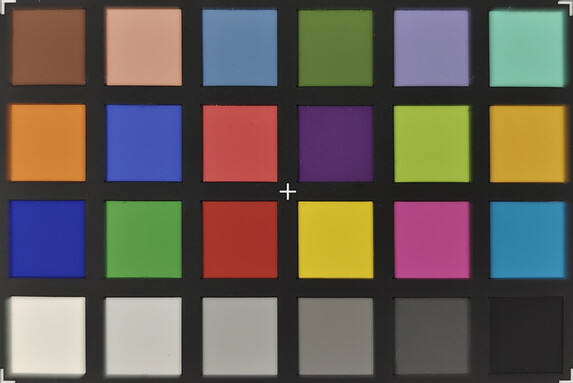
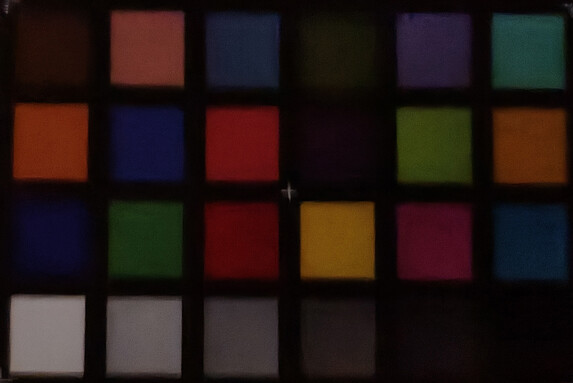
Accessories & Warranty - Large scope of delivery
The Vivo X80 Pro comes with a modular 80-watt power adapter, a matching USB cable, SIM tool, a black protective cover and a headset (USB-C). A charging station with a Qi-Pad is offered as an option.
Vivo grants a 24-month guarantee in Germany. This may vary in other countries, so be sure to check with your supplier before purchasing.
Input Devices & Operation - Huge ultrasonic FPS in the X80 Pro
The Vivo X80 Pro uses a capacitive touchscreen that detects up to ten touches simultaneously and works at a sampling rate of 300 Hz. Inputs are reliably recognized and quickly implemented. The factory-applied protective film offers good gliding properties, but does not cover the entire front glass surface.
A real highlight is the large 3D ultrasonic fingerprint sensor, which, according to Vivo, is 11.1 times larger than in conventional models. We immediately noticed the difference because instead of having to lift the finger up and down a number of times in order for detection to take place, a short touch is sufficient. The large surface is much more comfortable for the unlocking process. The recognition is not only very fast, but also precise. In addition, an app lock can be set up, which can then even be secured with two fingers. Furthermore, preselected apps can be opened directly from the lock screen. Additionally or alternatively, a less secure unlocking method in the form of facial recognition can be set up via the front-facing camera.
Display - Vivo X80 Pro with bright LTPO-AMOLED and 120 Hz
The 6.78-inch AMOLED screen of Vivo's X80 Pro works with QHD-Plus resolution and thus has a very high level of pixel density. This can be reduced to Full HD+ if desired. The refresh rate can optionally be set to 60 or 120 Hz, but can also be completely managed by the system and adapted to the respective content. In testing, we found that this is also the case with the nominally fixed refresh rates, which are gradually reduced to as low as 10 Hz.
Brightness amounts to an average of 947 cd/m² in a pure white display with the ambient light sensor activated. With an even distribution of light and dark areas (APL18), this even increases up to 1,255 cd/m², which should allow for an excellent HDR experience. HDR standards supported on the Vivo smartphone are HLG, HDR10, and HDR10+. Those who prefer to adjust the brightness manually have 467 cd/m² at their disposal.
OLED flickering is most pronounced at minimum display brightness and flickers between 179.6 and 361.7 Hz. Since DC dimming is not possible, sensitive users might find this irritating. We did not register any use of temporal dithering.
| |||||||||||||||||||||||||
Brightness Distribution: 97 %
Center on Battery: 938 cd/m²
Contrast: ∞:1 (Black: 0 cd/m²)
ΔE ColorChecker Calman: 0.9 | ∀{0.5-29.43 Ø4.78}
ΔE Greyscale Calman: 1.3 | ∀{0.09-98 Ø5}
94.8% sRGB (Calman 2D)
Gamma: 2.2
CCT: 6518 K
| Vivo X80 Pro AMOLED, 3200x1440, 6.8" | Samsung Galaxy S22 Ultra 5G Dynamic AMOLED, 3088x1440, 6.8" | Oppo Find X5 Pro AMOLED, 3216x1440, 6.7" | ZTE Axon 40 Ultra AMOLED, 2480x1116, 6.8" | Xiaomi 12 Pro AMOLED, 3200x1440, 6.7" | |
|---|---|---|---|---|---|
| Screen | -1% | -8% | -65% | -21% | |
| Brightness middle (cd/m²) | 938 | 1077 15% | 746 -20% | 682 -27% | 959 2% |
| Brightness (cd/m²) | 947 | 1093 15% | 744 -21% | 683 -28% | 977 3% |
| Brightness Distribution (%) | 97 | 97 0% | 97 0% | 94 -3% | 96 -1% |
| Black Level * (cd/m²) | |||||
| Colorchecker dE 2000 * | 0.9 | 1.2 -33% | 0.9 -0% | 1.8 -100% | 1.1 -22% |
| Colorchecker dE 2000 max. * | 1.9 | 2 -5% | 1.6 16% | 4.7 -147% | 3.1 -63% |
| Greyscale dE 2000 * | 1.3 | 1.3 -0% | 1.6 -23% | 2.4 -85% | 1.9 -46% |
| Gamma | 2.2 100% | 2.37 93% | 2.23 99% | 2.16 102% | 2.22 99% |
| CCT | 6518 100% | 6526 100% | 6499 100% | 6634 98% | 6498 100% |
* ... smaller is better
Screen Flickering / PWM (Pulse-Width Modulation)
| Screen flickering / PWM detected | 361.7 Hz | ||
The display backlight flickers at 361.7 Hz (worst case, e.g., utilizing PWM) . The frequency of 361.7 Hz is relatively high, so most users sensitive to PWM should not notice any flickering. However, there are reports that some users are still sensitive to PWM at 500 Hz and above, so be aware. In comparison: 53 % of all tested devices do not use PWM to dim the display. If PWM was detected, an average of 8111 (minimum: 5 - maximum: 343500) Hz was measured. | |||
Series of measurements at a fixed zoom level and different brightness settings
The color representation of the AMOLED display in the Vivo X80 Pro can be very accurate. To do this, however, the color mode Professional must be selected and the color temperature left at Standard. The panel then only works with the smaller sRGB color space, but color fidelity is then very good.
If you use the factory settings, you get a cooler and more saturated display, which, however, uses the larger DCI-P3 color space.
Display Response Times
| ↔ Response Time Black to White | ||
|---|---|---|
| 1.74 ms ... rise ↗ and fall ↘ combined | ↗ 0.9532 ms rise | |
| ↘ 0.7908 ms fall | ||
| The screen shows very fast response rates in our tests and should be very well suited for fast-paced gaming. In comparison, all tested devices range from 0.1 (minimum) to 240 (maximum) ms. » 9 % of all devices are better. This means that the measured response time is better than the average of all tested devices (20.2 ms). | ||
| ↔ Response Time 50% Grey to 80% Grey | ||
| 2.52 ms ... rise ↗ and fall ↘ combined | ↗ 1.037 ms rise | |
| ↘ 1.485 ms fall | ||
| The screen shows very fast response rates in our tests and should be very well suited for fast-paced gaming. In comparison, all tested devices range from 0.165 (minimum) to 636 (maximum) ms. » 11 % of all devices are better. This means that the measured response time is better than the average of all tested devices (31.6 ms). | ||
As expected, the viewing-angle stability of the Vivo smartphone is very good. There are no color inversions at any viewing angle, and we did not detect the iridescence that is typical of many OLEDs. At most, the display is a little cooler and the brightness wanes.
Performance - Snapdragon 8 Gen 1 in the X80 Pro
The Vivo X80 Pro is powered by a Snapdragon 8 Gen 1, which has 12 GB of LPDDR5 working memory. This can be increased by up to 4 GB if necessary and uses the flash storage for this.
The Vivo smartphone gives decent performance values in the CPU and system benchmarks. It only falls behind the competition a little in PCMark. Conversely, the results in the AI tests are even more convincing.
| UL Procyon AI Inference for Android - Overall Score NNAPI | |
| Vivo X80 Pro | |
| Average Qualcomm Snapdragon 8 Gen 1 (61568 - 81722, n=8) | |
| Oppo Find X5 Pro | |
| Xiaomi 12 Pro | |
| ZTE Axon 40 Ultra | |
| Average of class Smartphone (3769 - 81594, n=139, last 2 years) | |
| Samsung Galaxy S22 Ultra 5G | |
| AImark - Score v2.x | |
| Xiaomi 12 Pro | |
| Average Qualcomm Snapdragon 8 Gen 1 (1046 - 96317, n=14) | |
| ZTE Axon 40 Ultra | |
| Vivo X80 Pro | |
| Samsung Galaxy S22 Ultra 5G | |
| Oppo Find X5 Pro | |
Graphics processing is handled by the Adreno 730. A Vivo V1 Plus chip is also integrated, which, unlike the MariSilicon X in Oppo's Find X5 Pro, not only supports the DSP, but is also supposed to improve graphics processing. However, this is not noticeable in the benchmarks. The results are good, but not significantly better than other smartphones with the same GPU.
GFXBench (DX / GLBenchmark) 2.7: T-Rex Onscreen | 1920x1080 T-Rex Offscreen
GFXBench 3.0: on screen Manhattan Onscreen OGL | 1920x1080 1080p Manhattan Offscreen
GFXBench 3.1: on screen Manhattan ES 3.1 Onscreen | 1920x1080 Manhattan ES 3.1 Offscreen
GFXBench: on screen Car Chase Onscreen | 1920x1080 Car Chase Offscreen | on screen Aztec Ruins High Tier Onscreen | 2560x1440 Aztec Ruins High Tier Offscreen | on screen Aztec Ruins Normal Tier Onscreen | 1920x1080 Aztec Ruins Normal Tier Offscreen
| 3DMark / Wild Life Extreme Unlimited | |
| Oppo Find X5 Pro | |
| Xiaomi 12 Pro | |
| Vivo X80 Pro | |
| ZTE Axon 40 Ultra | |
| Samsung Galaxy S22 Ultra 5G | |
| 3DMark / Wild Life Extreme | |
| Xiaomi 12 Pro | |
| Oppo Find X5 Pro | |
| Vivo X80 Pro | |
| ZTE Axon 40 Ultra | |
| Samsung Galaxy S22 Ultra 5G | |
| 3DMark / Wild Life Unlimited Score | |
| Xiaomi 12 Pro | |
| Oppo Find X5 Pro | |
| Vivo X80 Pro | |
| ZTE Axon 40 Ultra | |
| Samsung Galaxy S22 Ultra 5G | |
| 3DMark / Wild Life Score | |
| Xiaomi 12 Pro | |
| Oppo Find X5 Pro | |
| Samsung Galaxy S22 Ultra 5G | |
| Vivo X80 Pro | |
| ZTE Axon 40 Ultra | |
| 3DMark / Sling Shot Extreme (ES 3.1) Unlimited Physics | |
| Vivo X80 Pro | |
| Xiaomi 12 Pro | |
| ZTE Axon 40 Ultra | |
| Samsung Galaxy S22 Ultra 5G | |
| Oppo Find X5 Pro | |
| 3DMark / Sling Shot Extreme (ES 3.1) Unlimited Graphics | |
| Oppo Find X5 Pro | |
| Vivo X80 Pro | |
| ZTE Axon 40 Ultra | |
| Xiaomi 12 Pro | |
| Samsung Galaxy S22 Ultra 5G | |
| 3DMark / Sling Shot Extreme (ES 3.1) Unlimited | |
| Vivo X80 Pro | |
| Oppo Find X5 Pro | |
| Xiaomi 12 Pro | |
| ZTE Axon 40 Ultra | |
| Samsung Galaxy S22 Ultra 5G | |
| 3DMark / Sling Shot OpenGL ES 3.0 Unlimited | |
| Oppo Find X5 Pro | |
| Vivo X80 Pro | |
| ZTE Axon 40 Ultra | |
| Xiaomi 12 Pro | |
| Samsung Galaxy S22 Ultra 5G | |
| 3DMark / Sling Shot OpenGL ES 3.0 Unlimited Graphics | |
| Oppo Find X5 Pro | |
| Vivo X80 Pro | |
| Xiaomi 12 Pro | |
| ZTE Axon 40 Ultra | |
| Samsung Galaxy S22 Ultra 5G | |
| 3DMark / Sling Shot OpenGL ES 3.0 Unlimited Physics | |
| Oppo Find X5 Pro | |
| Vivo X80 Pro | |
| ZTE Axon 40 Ultra | |
| Xiaomi 12 Pro | |
| Samsung Galaxy S22 Ultra 5G | |
| GFXBench (DX / GLBenchmark) 2.7 / T-Rex Onscreen | |
| Xiaomi 12 Pro | |
| Samsung Galaxy S22 Ultra 5G | |
| ZTE Axon 40 Ultra | |
| Oppo Find X5 Pro | |
| Vivo X80 Pro | |
| GFXBench (DX / GLBenchmark) 2.7 / T-Rex Offscreen | |
| ZTE Axon 40 Ultra | |
| Xiaomi 12 Pro | |
| Oppo Find X5 Pro | |
| Samsung Galaxy S22 Ultra 5G | |
| Vivo X80 Pro | |
| GFXBench 3.0 / Manhattan Onscreen OGL | |
| ZTE Axon 40 Ultra | |
| Xiaomi 12 Pro | |
| Samsung Galaxy S22 Ultra 5G | |
| Oppo Find X5 Pro | |
| Vivo X80 Pro | |
| GFXBench 3.0 / 1080p Manhattan Offscreen | |
| Xiaomi 12 Pro | |
| ZTE Axon 40 Ultra | |
| Samsung Galaxy S22 Ultra 5G | |
| Oppo Find X5 Pro | |
| Vivo X80 Pro | |
| GFXBench 3.1 / Manhattan ES 3.1 Onscreen | |
| ZTE Axon 40 Ultra | |
| Xiaomi 12 Pro | |
| Samsung Galaxy S22 Ultra 5G | |
| Vivo X80 Pro | |
| Oppo Find X5 Pro | |
| GFXBench 3.1 / Manhattan ES 3.1 Offscreen | |
| Xiaomi 12 Pro | |
| Samsung Galaxy S22 Ultra 5G | |
| ZTE Axon 40 Ultra | |
| Oppo Find X5 Pro | |
| Vivo X80 Pro | |
| GFXBench / Car Chase Onscreen | |
| ZTE Axon 40 Ultra | |
| Vivo X80 Pro | |
| Samsung Galaxy S22 Ultra 5G | |
| Oppo Find X5 Pro | |
| Xiaomi 12 Pro | |
| GFXBench / Car Chase Offscreen | |
| Xiaomi 12 Pro | |
| ZTE Axon 40 Ultra | |
| Samsung Galaxy S22 Ultra 5G | |
| Oppo Find X5 Pro | |
| Vivo X80 Pro | |
| GFXBench / Aztec Ruins High Tier Onscreen | |
| Vivo X80 Pro | |
| ZTE Axon 40 Ultra | |
| Oppo Find X5 Pro | |
| Samsung Galaxy S22 Ultra 5G | |
| Xiaomi 12 Pro | |
| GFXBench / Aztec Ruins High Tier Offscreen | |
| Oppo Find X5 Pro | |
| Xiaomi 12 Pro | |
| Vivo X80 Pro | |
| ZTE Axon 40 Ultra | |
| Samsung Galaxy S22 Ultra 5G | |
| GFXBench / Aztec Ruins Normal Tier Onscreen | |
| ZTE Axon 40 Ultra | |
| Vivo X80 Pro | |
| Oppo Find X5 Pro | |
| Xiaomi 12 Pro | |
| Samsung Galaxy S22 Ultra 5G | |
| GFXBench / Aztec Ruins Normal Tier Offscreen | |
| Oppo Find X5 Pro | |
| Xiaomi 12 Pro | |
| Vivo X80 Pro | |
| ZTE Axon 40 Ultra | |
| Samsung Galaxy S22 Ultra 5G | |
The Vivo X80 Pro's performance in the browser benchmarks is only average and sometimes falls well short of the expected rates. But this unnoticeable in everyday use and web browsing is very smooth.
| Jetstream 2 - 2.0 Total Score | |
| Average of class Smartphone (23.8 - 387, n=154, last 2 years) | |
| ZTE Axon 40 Ultra (Chrome 103.0.5060.71) | |
| Average Qualcomm Snapdragon 8 Gen 1 (72.8 - 134.6, n=16) | |
| Oppo Find X5 Pro (Chrome 99) | |
| Samsung Galaxy S22 Ultra 5G (Chrome 99) | |
| Xiaomi 12 Pro (Chrome 97) | |
| Vivo X80 Pro | |
| Speedometer 2.0 - Result 2.0 | |
| Average of class Smartphone (15.2 - 643, n=128, last 2 years) | |
| ZTE Axon 40 Ultra (Chrome 103.0.5060.71) | |
| Samsung Galaxy S22 Ultra 5G (Chrome 99) | |
| Oppo Find X5 Pro (Chrome 99) | |
| Average Qualcomm Snapdragon 8 Gen 1 (64.4 - 129.3, n=16) | |
| Vivo X80 Pro (Chrome 103) | |
| Xiaomi 12 Pro (Chrome 97) | |
| WebXPRT 3 - Overall | |
| Average of class Smartphone (38 - 380, n=35, last 2 years) | |
| Average Qualcomm Snapdragon 8 Gen 1 (79 - 193, n=15) | |
| Oppo Find X5 Pro (Chrome 99) | |
| Samsung Galaxy S22 Ultra 5G (Chrome 99) | |
| Xiaomi 12 Pro (Chrome 97) | |
| ZTE Axon 40 Ultra (Chrome 103.0.5060.71) | |
| Vivo X80 Pro (Chrome 103) | |
| Octane V2 - Total Score | |
| Average of class Smartphone (2228 - 121337, n=201, last 2 years) | |
| ZTE Axon 40 Ultra (Chrome 103.0.5060.71) | |
| Vivo X80 Pro (Chrome 103) | |
| Average Qualcomm Snapdragon 8 Gen 1 (27730 - 50626, n=17) | |
| Oppo Find X5 Pro (Chrome 99) | |
| Samsung Galaxy S22 Ultra 5G (Chrome 99) | |
| Xiaomi 12 Pro (Chrome 97) | |
| Mozilla Kraken 1.1 - Total | |
| Xiaomi 12 Pro (Chrome 97) | |
| Samsung Galaxy S22 Ultra 5G (Chrome 99) | |
| Vivo X80 Pro (Chrome 103) | |
| Average of class Smartphone (257 - 28190, n=156, last 2 years) | |
| Oppo Find X5 Pro (Chrome 99) | |
| Average Qualcomm Snapdragon 8 Gen 1 (814 - 1440, n=16) | |
| ZTE Axon 40 Ultra (Chrome 103.0.5060.71) | |
* ... smaller is better
The 256 GB UFS 3.1 storage of the Vivo smartphone is fast and shows excellent performance in all areas.
| Vivo X80 Pro | Samsung Galaxy S22 Ultra 5G | Oppo Find X5 Pro | ZTE Axon 40 Ultra | Xiaomi 12 Pro | Average 256 GB UFS 3.1 Flash | Average of class Smartphone | |
|---|---|---|---|---|---|---|---|
| AndroBench 3-5 | -15% | -37% | -16% | 4% | -11% | 9% | |
| Sequential Read 256KB (MB/s) | 1856.39 | 1653 -11% | 1410 -24% | 1638.15 -12% | 1620 -13% | 1757 ? -5% | 2223 ? 20% |
| Sequential Write 256KB (MB/s) | 1424.91 | 1074 -25% | 894 -37% | 1065.13 -25% | 1465 3% | 1204 ? -16% | 1838 ? 29% |
| Random Read 4KB (MB/s) | 303.72 | 322.3 6% | 183.7 -40% | 313.35 3% | 324.9 7% | 287 ? -6% | 295 ? -3% |
| Random Write 4KB (MB/s) | 382.17 | 273.1 -29% | 210.4 -45% | 273.19 -29% | 448.9 17% | 318 ? -17% | 335 ? -12% |
Gaming - Vivo smartphone is a real gamer
The Adreno 730 and the fast 120 Hz display ensure that the Vivo X80 Pro is predestined for gaming, since there is plenty of power and nothing stands in the way of high-frame-rate gaming, at least technically. The Vivo smartphone did not reveal any shortcomings in the tested games, which we recorded with GameBench, and delivered appealing and stable frame rates, even in the highest detail settings. However, Dead Trigger 2 stops at 60 FPS, although the game supports up to 120 FPS and the system is nominally strong enough.
A practical additional feature is the Ultra gaming mode, which is not as comprehensive as the X mode of the ROG Phone 6, but still offers a few useful settings, such as disabling notifications so as not to be disturbed during gaming.
Emissions - Smartphone with good speakers
Temperature
The surface temperatures of the Vivo X80 Pro remain pleasantly low at all times and does not even become lukewarm under constant load.
Inside the smartphone, however, it is a different story. In the 3DMark stress tests, the X80 Pro shows a continuous loss in performance over time, but it still remains slightly faster than the Find X5 Pro. But this is unlikely to be noticeable in everyday use since the performance reserves are very large.
(+) The maximum temperature on the upper side is 34.2 °C / 94 F, compared to the average of 35.2 °C / 95 F, ranging from 21.9 to 247 °C for the class Smartphone.
(+) The bottom heats up to a maximum of 32.5 °C / 91 F, compared to the average of 34 °C / 93 F
(+) In idle usage, the average temperature for the upper side is 29.1 °C / 84 F, compared to the device average of 32.9 °C / 91 F.
3DMark Wild Life Stress Test
| 3DMark | |
| Wild Life Stress Test Stability | |
| Vivo X80 Pro | |
| Oppo Find X5 Pro | |
| ZTE Axon 40 Ultra | |
| Samsung Galaxy S22 Ultra 5G | |
| Xiaomi 12 Pro | |
| Wild Life Extreme Stress Test | |
| Vivo X80 Pro | |
| ZTE Axon 40 Ultra | |
| Oppo Find X5 Pro | |
| Samsung Galaxy S22 Ultra 5G | |
| Xiaomi 12 Pro | |
Speakers
The two speakers of the Vivo X80 Pro have comparatively good sound output. At high volumes, low tones are not very present, which makes the sound a bit hollow. Alternatively, headphones can be connected via the USB-C port or wirelessly via Bluetooth. A wide range of audio codecs (SBC, AAC, aptX, aptX HD, aptX Adaptive, aptX TWS+ and LDAC) are available for the latter.
Vivo X80 Pro audio analysis
(+) | speakers can play relatively loud (89.4 dB)
Bass 100 - 315 Hz
(-) | nearly no bass - on average 22.4% lower than median
(+) | bass is linear (6.5% delta to prev. frequency)
Mids 400 - 2000 Hz
(+) | balanced mids - only 3.4% away from median
(+) | mids are linear (4.9% delta to prev. frequency)
Highs 2 - 16 kHz
(±) | higher highs - on average 5% higher than median
(+) | highs are linear (3.7% delta to prev. frequency)
Overall 100 - 16.000 Hz
(±) | linearity of overall sound is average (16% difference to median)
Compared to same class
» 5% of all tested devices in this class were better, 4% similar, 91% worse
» The best had a delta of 11%, average was 35%, worst was 134%
Compared to all devices tested
» 24% of all tested devices were better, 5% similar, 71% worse
» The best had a delta of 4%, average was 24%, worst was 134%
Xiaomi 12 Pro audio analysis
(+) | speakers can play relatively loud (84.2 dB)
Bass 100 - 315 Hz
(-) | nearly no bass - on average 18.8% lower than median
(±) | linearity of bass is average (12.9% delta to prev. frequency)
Mids 400 - 2000 Hz
(+) | balanced mids - only 4.2% away from median
(+) | mids are linear (4.4% delta to prev. frequency)
Highs 2 - 16 kHz
(+) | balanced highs - only 3.1% away from median
(+) | highs are linear (6.8% delta to prev. frequency)
Overall 100 - 16.000 Hz
(+) | overall sound is linear (14.8% difference to median)
Compared to same class
» 2% of all tested devices in this class were better, 2% similar, 96% worse
» The best had a delta of 11%, average was 35%, worst was 134%
Compared to all devices tested
» 19% of all tested devices were better, 4% similar, 77% worse
» The best had a delta of 4%, average was 24%, worst was 134%
Battery Life - Vivo X80 Pro with 4,700 mAh
Power Consumption
In our measurements, the Vivo X80 Pro shows increased power consumption when idling, although the LTPO display should actually be more economical here, since it can also lower the refresh rate below 60 Hz.
The Vivo smartphone has a lot to offer in terms of fast charging. Cabled charging has a capacity of 80 watts and a full charge took less than 40 minutes under testing. Wireless charging of 50 watts is also possible, and Vivo offers the corresponding charging station as an option. Users wanting to charge other devices wirelessly can use the smartphone as a charging surface because reverse wireless charging is also supported.
| Off / Standby | |
| Idle | |
| Load |
|
Key:
min: | |
| Vivo X80 Pro 4700 mAh | Samsung Galaxy S22 Ultra 5G 5000 mAh | Oppo Find X5 Pro 5000 mAh | ZTE Axon 40 Ultra 5000 mAh | Xiaomi 12 Pro 4600 mAh | Average Qualcomm Snapdragon 8 Gen 1 | Average of class Smartphone | |
|---|---|---|---|---|---|---|---|
| Power Consumption | 10% | 13% | 8% | 9% | -14% | -7% | |
| Idle Minimum * (Watt) | 0.92 | 0.58 37% | 1.24 -35% | 0.88 4% | 0.94 -2% | 1.255 ? -36% | 0.848 ? 8% |
| Idle Average * (Watt) | 2.04 | 0.71 65% | 1.39 32% | 1.57 23% | 1.24 39% | 2.02 ? 1% | 1.434 ? 30% |
| Idle Maximum * (Watt) | 2.05 | 1.16 43% | 1.42 31% | 1.6 22% | 1.34 35% | 2.21 ? -8% | 1.618 ? 21% |
| Load Average * (Watt) | 4.29 | 7.07 -65% | 3.58 17% | 5.06 -18% | 5.7 -33% | 5.49 ? -28% | 7.01 ? -63% |
| Load Maximum * (Watt) | 8.75 | 11.32 -29% | 6.99 20% | 7.91 10% | 8.12 7% | 8.75 ? -0% | 11.3 ? -29% |
* ... smaller is better
Power Consumption: Geekbench (150 cd/m²)
Power Consumption: GFXBench (150 cd/m²)
Battery Life
The 4,700 mAh battery of the Vivo X80 Pro is a little smaller than that of some rivals, but it still manages to generate good runtimes. Only the Galaxy S22 Ultra and the Axon 40 Ultra are better in comparison. In the "WLAN browsing" test, which is carried out with an adjusted display brightness of 150 cd/m², only ZTE's smartphone is better.
| Vivo X80 Pro 4700 mAh | Samsung Galaxy S22 Ultra 5G 5000 mAh | Oppo Find X5 Pro 5000 mAh | ZTE Axon 40 Ultra 5000 mAh | Xiaomi 12 Pro 4600 mAh | |
|---|---|---|---|---|---|
| Battery runtime | 20% | 6% | 31% | 4% | |
| Reader / Idle (h) | 28.8 | 32.9 14% | 21.2 -26% | 40.8 42% | 33.9 18% |
| H.264 (h) | 15.7 | 18 15% | 19 21% | 24.5 56% | 13.1 -17% |
| WiFi v1.3 (h) | 14.2 | 14.1 -1% | 13.1 -8% | 16.3 15% | 12.8 -10% |
| Load (h) | 4.5 | 6.8 51% | 6.1 36% | 4.9 9% | 5.6 24% |
Pros
Cons
Verdict: One of the best Android smartphones
The Vivo X80 Pro is one of the best Android smartphones currently available. Under testing, it scores well with its accurate LTPO AMOLED display, which can get very bright. The equipment is also almost complete and includes features such as fast wireless charging, even faster corded charging, IP certification, an IR blaster, good dual speakers and an excellent fingerprint sensor.
The Vivo X80 Pro impresses in most areas, but also has some points of criticism.
Vivo does not leave much room for criticism on the technical side of things. The cameras take great photos, but the low resolution quickly becomes a spoilsport when filming. At least users do not have to worry that the internal storage may be insufficient. On the other hand, an additional storage option would have certainly been desirable for those wanting to make extensive use of Ultra HD or even 8k. The omission of the 6 GHz band in the WLAN is incomprehensible in our view, especially since this should be mandatory in this price range. It would have also been nice to have more than three years of software updates.
Strong alternatives to the Vivo X80 Pro are the Samsung Galaxy S22 Ultra and the Oppo Find X5 Pro, but also the much cheaper Google Pixel 6 Pro.
Price and Availability
On the European mainland, the Vivo X80 Pro appears to be widely available via popular online retailers. For example, Amazon offers the smartphone in France and Italy for 1299€.
Outside the European mainland, availabilty becomes sporadic. The Vivo X80 Pro is out of stock at Amazon UK (as of 02.09.2022). We could not find the smartphone listed anywhere in the US, while it is offered in Canada via MI4Canada for CAD$1,495.00. In Australia, Best Mobile Phone offers the smarthpone for AUD$1,680.00. Shopee Mall in Singapore lists the smartphone for SNG$1,699.00.
All prices listed are as of 02.09.2022 and are subject to change.
Vivo X80 Pro
- 08/30/2022 v7 (old)
Daniel Schmidt




